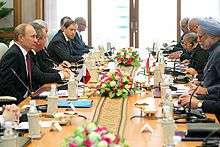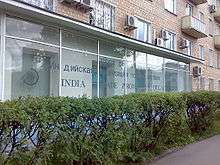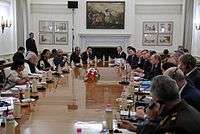India–Russia relations
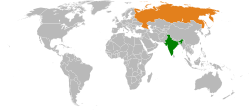 |
|
India |
Russia |
|---|---|

Indo-Russian relations (Russian: Российско-индийские отношения) (Hindi: भारत-रूस सम्बन्ध) refer to the bilateral relations between the Republic of India and the Russian Federation. During the Cold War, India and the Soviet Union (USSR) enjoyed a strong strategic, military, economic and diplomatic relationship. After the collapse of the USSR, Russia inherited the close relationship with India, even as India improved its relations with the West after the end of the Cold War.
Traditionally, the Indo-Russian strategic partnership has been built on five major components: politics, defence, civil nuclear energy, anti-terrorism co-operation and space.[1] These five major components were highlighted in a speech given by former Indian Foreign Secretary Ranjan Mathai in Russia.[1] However, in recent years a sixth component, economic, has grown in importance with both countries setting a target for US$30 billion in bilateral trade by 2025.[2][3][4] In order to facilitate this target both countries are looking to develop a free trade agreement.[5][6][7] Bilateral trade between both countries in 2012 grew by over 24%.[7]
The powerful IRIGC is the main body that conducts affairs at the governmental level between both countries.[8] Both countries are members of many international bodies where they jointly collaborate closely on matters of shared national interest. Important examples include the UN, BRICS, G20 and SCO where India has observer status and has been asked by Russia to become a full member.[9] Russia has stated publicly that it supports India receiving a permanent seat on the United Nations Security Council.[10] In addition, Russia has expressed interest in joining SAARC with observer status in which India is a founding member.[11][12]
India is the second largest market for the Russian defence industry. In 2004, more than 70% of the Indian Military's hardware came from Russia, making Russia the chief supplier of defence equipment.[13] India has an embassy in Moscow and two consulates-general (in Saint Petersburg and Vladivostok). Russia has an embassy in New Delhi and four consulates-general (in Chennai, Hyderabad, Kolkata, Mumbai).
According to a 2014 BBC World Service Poll, 45% of Russians view India positively, with only 9% expressing a negative view.[14]
Soviet Union and India
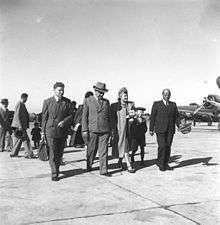
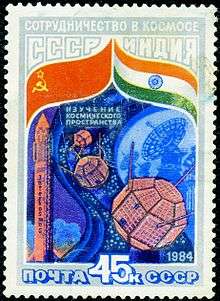
A cordial relationship with India that began in the 1950s represented the most successful of the Soviet attempts to foster closer relations with Third World countries. The relationship began with a visit by Indian Prime Minister Jawaharlal Nehru to the Soviet Union in June 1955 and Khrushchev's return trip to India in the fall of 1955. While in India, Khrushchev announced that the Soviet Union supported Indian sovereignty over the disputed territory of the Kashmir region and over Portuguese coastal enclaves such as Goa.
The Soviet Union's strong relations with India had a negative impact upon both Soviet relations with the People's Republic of China, including Indian relations with the PRC, during the Khrushchev period. The Soviet Union declared its neutrality during the 1959 border dispute and the Sino-Indian war of October 1962, although the Chinese strongly objected. The Soviet Union gave India substantial economic and military assistance during the Khrushchev period, and by 1960 India had received more Soviet assistance than China had.[15] This disparity became another point of contention in Sino-Soviet relations. In 1962 the Soviet Union agreed to transfer technology to co-produce the Mikoyan-Gurevich MiG-21 jet fighter in India, which the Soviet Union had earlier denied to China.[15][16]
In 1965 the Soviet Union served successfully as peace broker between India and Pakistan after an Indian-Pakistani border war. The Soviet Chairman of the Council of Ministers, literally Premier of the Soviet Union, Alexei Kosygin, met with representatives of India and Pakistan and helped them negotiate an end to the military conflict over Kashmir.
In 1971 the former East Pakistan region initiated an effort to secede from its political union with West Pakistan. India supported the secession and, as a guarantee against possible Chinese entrance into the conflict on the side of West Pakistan, it signed with the Soviet Union the Indo-Soviet Treaty of Friendship and Cooperation in August 1971. In December, India entered the conflict and ensured the victory of the secessionists and the establishment of the new state of Bangladesh.
Relations between the Soviet Union and India did not suffer much during the rightist Janata Party's coalition government in the late 1970s, although India did move to establish better economic and military relations with Western countries. To counter these efforts by India to diversify its relations, the Soviet Union proffered additional weaponry and economic assistance.
During the 1980s, despite the 1984 assassination by Sikh separatists of Prime Minister Indira Gandhi, the mainstay of cordial Indian-Soviet relations, India maintained a close relationship with the Soviet Union. Indicating the high priority of relations with the Soviet Union in Indian foreign policy, the new Indian prime minister, Rajiv Gandhi, visited the Soviet Union on his first state visit abroad in May 1985 and signed two long-term economic agreements with the Soviet Union. In turn, Gorbachev's first visit to a Third World state was his meeting with Prime Minister Rajiv Gandhi in New Delhi in late 1986. Mikhail Gorbachev unsuccessfully urged Gandhi to help the Soviet Union set up an Asian collective security system. Gorbachev's advocacy of this proposal, which had also been made by Leonid Brezhnev, was an indication of continuing Soviet interest in using close relations with India as a means of containing China. With the improvement of Sino-Soviet relations in the late 1980s, containing China had less of a priority, but close relations with India remained important as an example of Gorbachev's new Third World policy.
Russia and India
Relations with India have always been and I am sure will be one of the most important foreign policy priorities of our country. Our mutual ties of friendship are filled with sympathy, and trust, and openness. And we must say frankly that they were never overshadowed by disagreements or conflict. This understanding - this is indeed the common heritage of our peoples. It is valued and cherished in our country, in Russia, and in India. And we are rightfully proud of so close, so close relations between our countries.
We are confident that India lives in the hearts of every Russian. In the same way, I can assure you that Russia also lives in our souls as a Homeland, as people who share our emotions, our feelings of mutual respect and constant friendship. Long live our friendship!
"...India-Russia relationship is one of deep friendship and mutual confidence that would not be affected by transient political trends.Russia has been a pillar of strength at difficult moments in India's history. India will always reciprocate this support. Russia is and will remain our most important defense partner and a key partner for our energy security, both on nuclear energy and hydrocarbons,"
Political relations
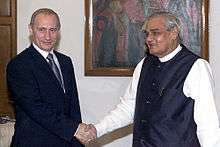

The first major political initiative, since the collapse of the Soviet Union, between India and Russia began with the Strategic Partnership signed between the two countries in 2000. President Vladimir Putin stated in an article written by him in the Hindu, "The Declaration on Strategic Partnership between India and Russia signed in October 2000 became a truly historic step".[19][20] Former Prime Minister Manmohan Singh also agreed with his counterpart by stated in speech given during President Putin's 2012 visit to India, "President Putin is a valued friend of India and the original architect of the India-Russia strategic partnership".[21] Both countries closely collaborate on matters of shared national interest these include at the UN, BRICS, G20 and SCO where India has observer status and has been asked by Russia to become a full member.[9] Russia also strongly supports India receiving a permanent seat on the United Nations Security Council.[10] In addition, Russia has vocally backed India joining the NSG[22] and APEC.[23] Moreover, it has also expressed interest in joining SAARC with observer status in which India is a founding member.[12][24]
Russia currently is one of only two countries in the world (the other being Japan) that has a mechanism for annual ministerial-level defence reviews with India.[1] The Indo-Russian Inter-Governmental Commission (IRIGC) is one of the largest and most comprehensive governmental mechanisms that India has had with any country internationally. Almost every department from the Government of India attends it.[1]
IRIGC
The Indo-Russian Inter-Governmental Commission (IRIGC) is the main body that conducts affairs at the governmental level between both countries.[8] Some have described it as the steering committee of Indo-Russia relations.[8] It is divided into two parts, the first covering Trade, Economic, Scientific, Technological and Cultural Co-operation. This is normally co-chaired by the Russian Deputy Prime Minister and the Indian External Affairs Minister. The second part of the commission covers Military Technical Co-operation this is co-chaired by the two countries respective Defence Ministers. Both parts of IRIGC meet annually.[8]
In addition, to the IRIGC there are other bodies that conduct economic relations between the two countries. These include, the Indo-Russian Forum on Trade and Investment, the India-Russia Business Council, the India-Russia Trade, Investment and Technology Promotion Council and the India-Russia Chamber of Commerce.[25]
Military relationship
.jpg)
.jpg)
.jpg)
.jpg)
.jpg)
Defence relations between India and the Russian Federation have a historical perspective. The Soviet Union was an important supplier of defence equipment for several decades, and that relationship was inherited by Russia after the break-up of the Soviet Union. In 1997, Russia and India signed a ten-year agreement for further military-technical cooperation. That agreement encompassed a wide range of activities, including the purchase of completed weaponry, joint development and production, and joint marketing of armaments and military technologies.[26]
Today, the co-operation is not limited to a buyer-seller relationship but includes joint research and development, training, service to service contacts, including joint exercises. The last joint naval exercises took place in April 2007 in the Sea of Japan and joint airborne exercises were held in September 2007 in Russia.
An Inter-Governmental commission on military-technical co-operation is co-chaired by the defence ministers of the two countries. The seventh session of this Inter-Governmental Commission was held in October 2007 in Moscow. During the visit, an agreement on joint development and production of prospective multi-role fighters was signed between the two countries.
An India–Russia co-operation agreement was signed in December 1988. It has resulted in the sale of a multitude of defence equipment to India and also the emergence of the countries as development partners as opposed to purely a buyer-seller relationship. Two programmes that evidence this approach are the projects to form Indian-Russian joint ventures to develop and produce the Fifth Generation Fighter Aircraft (FGFA) and the Multirole Transport Aircraft (MTA). The agreement is pending a 10-year extension.[27]
India and Russia have several major joint military programmes including:
- BrahMos cruise missile programme
- 5th generation fighter jet programme
- Sukhoi Su-30MKI programme (230+ to be built by Hindustan Aeronautics)
- Ilyushin/HAL Tactical Transport Aircraft
Additionally, India has purchased/leased various military hardware from Russia:
- S-400 Triumf 12.
- Kamov Ka-226 200 to be made in India under the Make in India initiative.
- T-90S Bhishma with over 1000 to be built in India
- Akula-II nuclear submarine (2 to be leased with an option to buy when the lease expires)
- INS Vikramaditya aircraft carrier programme
- Tu-22M3 bombers (4 ordered)
- US$900 million upgrade of MiG-29
- Mil Mi-17 (80 ordered) more in Service.
- Ilyushin Il-76 Candid (6 ordered to fit Israeli Phalcon radar)
- The Farkhor Air Base in Tajikistan is currently jointly operated by Indian Air Force and Tajikistan Air Force.
Both countries signed a defence deal worth $2.9 billion during President Putin's visit to India in December 2012. The 42 new Sukhois, to be produced under licence by defence PSU Hindustan Aeronautics, will add to the 230 Sukhois earlier contracted from Russia. Overall, the price tag for the 272 Sukhois - three of the over 170 inducted till now have crashed - stands at over $12 billion. The medium-lift Mi-17 V5 helicopters (59 for IAF and 12 for home ministry/BSF) will add to the 80 such choppers already being inducted under a $1.34 billion deal inked in 2008. The value of India's defence projects with Russia will further zoom north after the imminent inking of the final design contract for the joint development of a futuristic stealth fifth-generation fighter. This R&D contract is itself pegged at US$11 billion, to be shared equally by the two countries. So if India inducts over 200 of these 5th Gen fighters, as it hopes to do from 2022 onwards, the overall cost of this gigantic project for India will come to around US$35 billion since each of the jets will come for upwards of US$100 million at least.[20]
Joint Military Exercises
INDRA
.jpg)
.jpg)
INDRA is a joint, bi-annual military exercise conducted by India and Russia starting in 2003. The exercise is tasked with boosting cooperation and interoperability between the Russian and Indian navies. The word INDRA is a portmanteau of the participants' respective countries.[28]
The exercise involves live firing drills, as well as air defence and anti submarine operations. Additionally, counterpiracy, terrorism and drug smuggling operations are carried out.[29]
Avia-Indra
Avia-Indra is annual military exercise conducted by the Air forces of India and Russia that is held in two parts. In 2014 the first part of the exercise was held in the Astrakhan region, close to the Caspian Sea in Russia and the second part was held in Halwara, Punjab in India.[30][31] The objective of the exercise is to improve operational interoperability between the respective Air forces and training.[31][32] Aircraft involved in the exercise included Su-30MKIs, Su-30SMs, MiG-21s, Mi-17 & Mi-35 helicopters.[31][33]
Economic relations
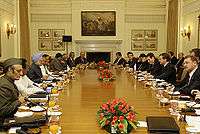
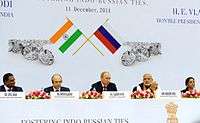
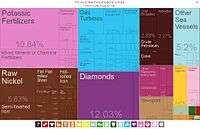



Bilateral trade between both countries is concentrated in key value chain sectors. These sectors include highly diversified segments such as machinery, electronics, aerospace, automobile, commercial shipping, chemicals, pharmaceuticals, fertilisers, apparels, precious stones, industrial metals, petroleum products, coal, high-end tea and coffee products.[34] Bilateral trade in 2002 stood at $1.5 billion[35] and increased by over 7 times to $11 billion in 2012[36] and with both governments setting a bilateral trade target of $30 billion by 2025.[3][4][34] Bilaterial bodies that conduct economic relations between the two countries include IRIGC, the Indo-Russian Forum on Trade and Investment, the India-Russia Business Council, the India-Russia Trade, Investment and Technology Promotion Council, the India-Russia CEOs' Council and the India-Russia Chamber of Commerce.[34][37]
Both Governments have jointly developed an economic strategy that involves using a number of economic components to increase future bilateral trade. These include development of an FTA between India & the EEU, a bilateral treaty on the promotion and protection of investments, a new economic planning mechanism built into IRIGC, simplication of customs procedures, new long term agreements in the expansion of energy trade including nuclear, oil and gas.[38][39] Finally, long term supplier contracts in key sectors such as oil, gas and rough diamonds. Companies such as Rosneft, Gazprom, Essar & Alrosa will act as long term suppliers respectively.[39]
Russia has stated it will co-operate with India on its "Make in India" initiative by engagement in the development of "Smart Cites", the DMIC, the aerospace sector, the commercial nuclear sector and enhancement in manufacturing of Russian military products through co-development and co-production.[3][40][41][42] Russia agreed to participate in the vast, over $100 billion, DMIC infrastructure project which will eventually connect Delhi and Mumbai with railways, highways, ports, interconnecting smart cities and industrial parks.[3] Russian President Vladimir Putin stated in an interview that one of his government’s priorities was of building a smart city in India, "a smart city on the basis of Russian technologies."[43] AFK Sistema will likely be the primary Russian company involved in the project due to its previous experience in smart city projects in Ufa, Kazan and Rostov.[44]
Both countries have also agreed to work together in the aerospace sector to co-development and co-produce aircraft, examples include the Sukhoi Superjet 100, MS-21, FGFA, MTA and Kamov Ka-226.[41] Some of the co-developed aircraft will be jointly commercially exported to third countries and foreign markets e.g. FGFA and Kamov Ka-226. President of Russia's UAC Mikhail Pogosyan stated in an interview, "We are planning to sell in India about 100 passenger aircraft by 2030, which will account for 10 percent of the Indian market of airliners in the segment" and further stated, "The unprecedented scope of Russian-Indian cooperation in military aviation has created a scientific and engineering basis for undertaking joint projects in civil aviation."[41]
India is currently the world's largest cutting & polishing centre for diamonds. Both countries have agreed to streamline their bilateral trade in diamonds through reductions in regulations and tariffs. Indian Prime Minister Modi stated in an interview, "I made three proposals to President Putin. First, I would like Alrosa to have direct long-term contracts with more Indian companies. I am pleased to know that they are moving in this direction. Second, I want Alrosa and others to trade directly on our diamond bourse. We have decided to create a Special Notified Zone where mining companies can trade diamonds on consignment basis and re-export unsold ones. Third, I asked to reform regulation so that Russia can send rough diamonds to India and reimport polished diamonds without extra duties".[45][46] Analysts predict through streamlined procedures and initiatives bilateral trade in this area will significantly increase.[42]
Russia has agreed to build more than 20 nuclear reactors over the next 20 year.[40][47] Russian president stated in an interview, "It contains plans to build over 20 nuclear power units in India, as well as cooperation in building Russia-designed nuclear power stations in third countries, in the joint extraction of natural uranium, production of nuclear fuel and waste elimination."[40] In 2012 Gazprom Group and India's GAIL agreed to LNG shipments to India of 2.5 million tons a year for the period of 20 years. LNG shipments for this contract are expected to begin anytime between 2017-21.[48] Indian oil companies have invested in the Russia's oil sector a notable example is ONGC-Videsh which has invested over $8 billion with major stakes in oil fields such Sakhalin-1.[49] In joint statement released by both governments they stated, "It is expected that Indian companies will strongly participate in projects related to new oil and gas fields in the territory of the Russian Federation. The sides will study the possibilities of building a hydrocarbon pipeline system, connecting the Russian Federation with India."[3]
Officials from both countries have discussed how to increase co-operation between their countries respective IT industries. Russian Minister of Communication Nikolai Nikiforov stated in an interview, "The development of IT products and software has traditionally been a strong point of India. We welcome possible joint projects in the field and closer contacts between Russian and Indian companies."[50]
Due to India simplifying recent visa rule changes for Russians travelling to India, the number of tourists increased by over 22%.[51] In 2011 the Indian consulates in Moscow, Vladivostok and St. Petersburg issued 160,000 visas, an increase of over 50% compared to 2010.[51]
Russian imports from India amounted to $3.1 billion or 1% of its overall imports, and 0.7% of India's overall exports in 2014. The 10 major commodities exported from India to Russia were:[52][53]
| Indian commodities exports to Russia (2014)[52][53] | |
|---|---|
| Product category | Quantity ($ million) |
| Pharmaceuticals | $819.1 |
| Electronic equipment | $382.3 |
| Machines, engines, pumps | $159.4 |
| Iron and steel | $149.1 |
| Clothing (not knit or crochet) | $135.7 |
| Coffee, tea and spices | $131.7 |
| Tobacco | $113.9 |
| Vehicles | $111.1 |
| Knit or crochet clothing | $97.9 |
| Other food preparations | $77.7 |
Russian exports to India amounted to $6.2 billion or 1.3% of its overall exports, and 0.9% of India's overall imports in 2014. The 10 major commodities exported from Russia to India were:[54][55]
| Russian commodities exports to India (2014)[54][55] | |
|---|---|
| Product category | Quantity ($ million) |
| Gems, precious metals, coins | $1100.0 |
| Machines, engines, pumps | $707.4 |
| Electronic equipment | $472.7 |
| Fertilizers | $366.8 |
| Medical, technical equipment | $302.7 |
| Oil | $223.8 |
| Iron and steel | $167.4 |
| Paper | $136.8 |
| Inorganic chemicals | $127.4 |
| Salt, sulphur, stone, cement | $105.1 |
Free trade agreement (FTA)
.jpg)
Both governments have long viewed their bilateral trade well below its optimal potential, with the only long term way of rectifying this through having a Free trade agreement (FTA).[56][57] Both governments have set up a joint study group (JSG) to negotiate the specifications of an agreement, a final agreement would be signed between India and Eurasian Economic Union of which Russia is a part of (also including Kazakhstan, Armenia, Kyrgyzstan & Belarus).[58] Thereby, the Indo-Russian FTA would result in a much bigger free trade agreement including India, Russia, Kazakhstan, Armenia, Kyrgyzstan & Belarus.[56] It is predicted once an FTA is in place bilateral trade will increase manifold, thereby significantly increasing the importance of economics in bilateral ties.[56][59][60]
The table below shows the recent Indo-Russian bilateral trade performance:
| Indo-Russian trade (2009–12) | ||
|---|---|---|
| Year | Trade Volume (Billion $) | Annual Change |
| 2009 | $7.46[7] | |
| 2010 | $8.53[7] | +14.34% |
| 2011 | $8.87[7] | +3.98% |
| 2012 | $11.04[7] | +24.50% |
Co-operation in the Energy sector
Energy sector is an important area in Indo-Russian bilateral relations. In 2001, ONGC-Videsh acquired 20% stake in the Sakhalin-I oil and gas project in the Russian Federation, and has invested about US $1.7 billion in the project. The Russian company Gazprom and Gas Authority of India. have collaborated in joint development of a block in the Bay of Bengal. Kudankulam Nuclear Power Project with two units of 1000 MW each is a good example of Indo-Russian nuclear energy co-operation. Both sides have expressed interest in expanding co-operation in the energy sector.
In December 2008, Russia and India signed an agreement to build civilian nuclear reactors in India during a visit by the Russian president to New Delhi.[61]
Space Co-operation
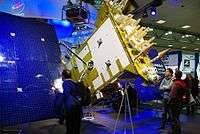
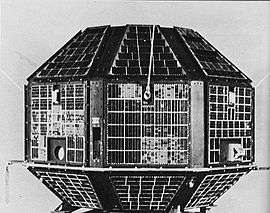
Historically, there has been a long history of cooperation between the Soviet Union and India in Space. Examples include Aryabhata it was India's first satellite,[62] named after an Indian astronomer of the same name.[63] It was launched by the Soviet Union on 19 April 1975[62] from Kapustin Yar using a Kosmos-3M launch vehicle. During President Vladimir Putin's visit to India in December 2004, two space-related bilateral agreements were signed viz. Inter-Governmental umbrella Agreement on co-operation in the outer space for peaceful purposes and the Inter Space Agency Agreement on co-operation in the Russian satellite navigation system GLONASS. Subsequently, a number of follow-up agreements on GLONASS have been signed. In November 2007, the two countries have signed an agreement on joint lunar exploration. These space co-operation programmes are under implementation. Chandrayaan-2 is a joint lunar exploration mission proposed by the Indian Space Research Organisation (ISRO) and the Russian Federal Space Agency (RKA) and has a projected cost of 4.25 billion (US$90 million). The mission, proposed to be launched in 2017 by a Geosynchronous Satellite Launch Vehicle (GSLV) launch vehicle, includes a lunar orbiter and a rover made in India as well as one lander built by Russia.
Science and Technology
The ongoing collaboration in the field of science & technology, under the Integrated Long-Term Programme of Co-operation (ILTP) is the largest co-operation programme in this sphere for both India and Russia. ILTP is coordinated by the Department of Science and Technology from the Indian side and by the Russian Academy of Sciences and Russian Ministry of Industry & Science and Technology from the Russian side. Development of SARAS Duet aircraft, semiconductor products, super computers, poly-vaccines, laser science and technology, seismology, high-purity materials, software & IT and Ayurveda have been some of the priority areas of co-operation under the ILTP. Under this programme, eight joint Indo-Russian centres have been established to focus on joint research and development work. Two other Joint Centres on Non-ferrous Metals and Accelerators and Lasers are being set up in India. A Joint Technology Centre based in Moscow to bring cutting edge technologies to the market is also under processing. An ILTP Joint Council met in Moscow on 11–12 October 2007 to review co-operation and give it further direction. In August 2007, an MoU was signed between Department of Science and Technology and Russian Foundation of Basic Research, Moscow to pursue scientific co-operation.
North-South Transport Corridor
.jpg)
The North–South Transport Corridor is the ship, rail, and road route for moving freight between India, Russia, Iran, Europe and Central Asia. The route primarily involves moving freight from India, Iran, Azerbaijan and Russia via ship, rail and road.[64] The objective of the corridor is to increase trade connectivity between major cities such as Mumbai, Moscow, Tehran, Baku, Bandar Abbas, Astrakhan, Bandar Anzali etc.[65] Dry runs of two routes were conducted in 2014, the first was Mumbai to Baku via Bandar Abbas and the second was Mumbai to Astrakhan via Bandar Abbas, Tehran and Bandar Anzali. The objective of the study was to identify and address key bottlenecks.[66][67] The results showed transport costs were reduced by "$2,500 per 15 tons of cargo".[67] Other routes under consideration include via Armenia, Kazakhstan and Turkmenistan.
Cooperation in the cultural sphere
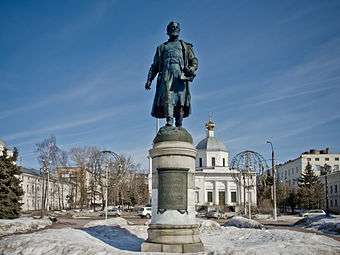
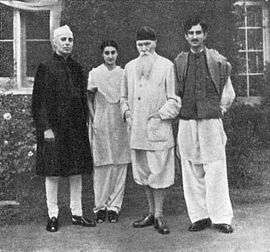
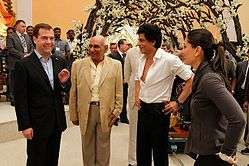
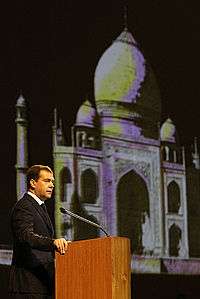
Indo–Russian relations in the field of culture are historical. One of the first Russian visitors to India was Afanasiy Nikitin a merchant from Tver in Russia.[68][69] His famous journey (1466-1472) was documented in the book A Journey Beyond the Three Seas. Nikitin spent three years in India (1469-1472) travelling to its many regions and documenting its people, culture, economy, technology, history, society and food. Nikitin's journey was portrayed by Soviet actor Oleg Strizhenov alongside Hindi screen legend Nargis Dutt in the 1950s film Journey Beyond Three Seas.[70][71]
Astrakhan in Russia has historically been a trading centre for Indian merchants since the 16th century.[72] In 1722 Peter the Great met with Anbu-Ram the leader of the Indians merchants in Astrakhan. In the meeting Peter the Great agreed to Anbu-Ram's request for full free trade including transit rights.[73]
The first Russian translation of the Bhagavad Gita was published in 1788 by decree on the orders of Catherine the Great.[74] Russian pioneers who travelled to India and studied Indian culture include Gerasim Lebedev who studied ancient Indian languages in the 1780s[75][76] and later Nicholas Roerich who studied Indian philosophy.[77] Roerich was influenced by the philosophy of Ramakrishna and Vivekananda, the poetry of Rabindranath Tagore, and the Bhagavad Gita. The 130th birth anniversary of Nicholas Roerich and 100th birth anniversary of Svetoslav Roerich were celebrated in India in October 2004.
Leading Russian Indiologist such as Ivan Minayev, Sergey Oldenburg, Fyodor Shcherbatskoy, Yuri Knorozov, Alexandr Kondratov, Nikita Gurov and Eugene Chelyshev focused their research in understanding the Indus Script, Sanskrit and Indian literature.[75][78]
Traditionally, there has been strong collaboration in the field of cinema between India and the USSR. Several generations of Russians grew up watching subtitled Indian films (mainly Bollywood) and vice versa for Indians watching Russian films.[79] Popular Indian films in the USSR included Awara, Bobby, Barood, Mamta[80][81] and Disco Dancer.[82] Recent contemporary films entirely shot in Russia include Lucky: No Time for Love. However, after the collapse of the USSR Bollywood's market share decreased in Russia.[83] Recently, however, there has been increase due to viewers having access through cable and satellite channels.[81][84] The Russian Deputy Minister of Culture, Elena Milovzorova, stated in an interview that an Indian-Russian joint working group (JWG) would discuss procedures to allow for both countries film industries to collaborate in film production together.[79] The Krasnodar Region has been discussed among officials as a possible area for shooting future Bollywood films.[85] Former Russian President Dmitry Medvedev know to be admirer of Bollywood films[86][87] visited the film set of Yash Raj Studios and met Bollywood stars such as Shah Rukh Khan, Yash Chopra and Kareena Kapoor. He stated in an interview, "Our country is one of the places where Indian culture is most admired" in addition stated, "Russia and India are the only countries where satellite channels broadcast Indian movies 24/7."[86]
Yoga in Russia has been growing and becoming increasingly popular since the 1980s, particularly in majors cities and urban centres, mainly due to its reputation for health benefits.[74][88][89] However, it has its roots much earlier in Russia during the time of noted Russian actor and trainer Constantin Stanislavski who was significantly influenced by Yoga and Indian philosophy.[74][90][91]
Russia's Rossotrudnichestvo Representative Office (RRO) established in 1965 has five Russian Centres of Science and Culture (RCSC) in India they include New Delhi, Mumbai, Kolkata, Chennai and Trivandrum.[92] The head of RRO and director of RCSC, Fyodor Rozovsky, expects cultural ties to grow between both countries.[92] He and other officials also expects the number of Indian students studying in Russia to increase once both countries sign an agreement on joint recognition of higher education diplomas.[93][94][95] There is a Hindi Department, in the University of Moscow along with five Chairs relating to Indology in Moscow, Saint Petersburg, Kazan and Vladivostok.
Days of Russian Culture were held in India in November 2003, in Delhi, Kolkata and Mumbai. "Days of Indian Culture" in Russia were organised from September to October 2005 in Russia. Chief Minister of National Capital Territory of Delhi led a delegation for participating in the event "Days of Delhi in Moscow" from 28 May 1 June 2006. The "Year of Russia in India" was held in 2008. It was followed by the "Year of India in Russia" in 2009.
Terrorism
On international terrorism, India and Russia agree that there is no justification for terrorism, and this must be fought against, without compromise and wherever it exists. Russia has supported the Indian draft at the UN on Comprehensive Convention on International Terrorism [CCIT]. The two sides signed a MoU on co-operation in combating terrorism in December 2002. A Joint Working Group on Combating International Terrorism meets from time to time and its fourth meeting was held in Delhi on 24 October 2006. Both Russia and India have faced the problem of terrorism, India has seen it in the context of its military presence in Kashmir and Russia has seen it in Chechnya and both the countries are supportive of each other on the issue of terrorism.
Nuclear Deals
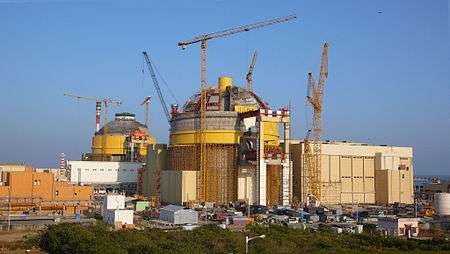
On 7 November 2009, India signed a new nuclear deal with Russia apart from the deals that were agreed upon by the two countries earlier.[96] India and Russia are in discussion for construction of two more nuclear power units at Kudankulam. Two units of the Kudankulam Nuclear Power Plant are already operational. During Russian president Vladimir Putin's visit to India for the 13th annual summit, a co-operative civilian nuclear energy road map was agreed to. Running until 2030, sixteen to eighteen new reactors will be constructed, with installed capacity of 1,000 MW each. A 1,000 MW reactor costs around $2.5 billion so the deal may touch $45 billion in worth.[97]
See also
- Indo-Soviet Treaty of Friendship and Cooperation
- Foreign relations of India
- Foreign relations of Russia
- Bollywood: Popularity and appeal
- Embassy of India School Moscow
- Indians in Russia
- Russians in India
- Hinduism in Russia
- Buddhism in Russia
Further reading
- A New Era: India-Russia ties in 21st century. ISBN NO:9780988841932 Publisher:Russia Beyond The Headlines
- How India’s cryogenic programme was wrecked by USA
- Challenges and Opportunities: Russia and the Rise of China and India by Dmitri Trenin, Strategic Asia 2011-12: Asia Responds to Its Rising Powers - China and India (September 2011)
- 1971 Indo-Pakistan War: Role of Russia by Sanskar Shrivastava, "The World Reporter" (October 2011)
External links
| Wikimedia Commons has media related to Relations of India and Russia. |
- Brief on India-Russia Relations by Ministry of External Affairs, India
- Indian embassy in Moscow
- Russian embassy in New Delhi
- India Russia Report
- Sputnik News India
References
- 1 2 3 4 Top Indian diplomat explains Russia's importance to India: Russia & India Report
- ↑ "Bilateral Relations: India-Russia Relations". Embassy of India Moscow. 1 December 2014. Retrieved 8 February 2015.
- 1 2 3 4 5 "Narendra Modi-Vladimir Putin meet: India, Russia to explore oil and gas; aim for $30 bn trade". The Financial Express. 12 December 2014. Retrieved 8 February 2015.
- 1 2 "India-Russia trade relations back in Spotlight". The Dollar Business. 5 January 2015. Retrieved 8 February 2015.
- ↑ "India asks Russia to fast-track free trade pact proposal". timesofindia-economictimes. Retrieved 24 April 2016.
- ↑ "India, Russia mull free trade agreement". Retrieved 24 April 2016.
- 1 2 3 4 5 6 "India, Russia to negotiate on CECA with Customs Union". Russia & India Report. 3 April 2013.
- 1 2 3 4 Indo-Russian Inter-Governmental Commission to meet in mid-October: Russia & India Report
- 1 2 NK. "Top News Stories". Archived from the original on 2 April 2012. Retrieved 24 April 2016.
- 1 2 Sputnik (16 December 2011). "Russia backs India as possible UN Security Council permanent member". Retrieved 24 April 2016.
- ↑ SAARC The Changing Dimensions: UNU-CRIS Working Papers United Nations University - Comparative Regional Integration Studies
- 1 2 "Russia keen to join SAARC as observer". www.oneindia.com. Retrieved 24 April 2016.
- ↑ John Pike. "VOA News Report". Retrieved 24 April 2016.
- ↑ 2014 World Service Poll BBC
- 1 2 citation needed
- ↑ Donaldson, Robert H (1972). "India: The Soviet Stake in Stability". Asian Survey. 12 (6): 475. doi:10.2307/2643045. JSTOR 2643045.
- 1 2 "Торжественный вечер, посвящённый Году Индии в России". Президент России. Retrieved 24 April 2016.
- ↑ "Russia a dependable partner of India: President Pranab Mukherjee". CNN-IBN. 11 May 2015. Retrieved 11 May 2015.
- ↑ Vladimir Putin. "For Russia, deepening friendship with India is a top foreign policy priority". The Hindu. Retrieved 24 April 2016.
- 1 2 "India, Russia sign new defence deals". BBC News. Retrieved 24 April 2016.
- ↑ 13th Indo-Russian Summit reaffirms time-tested ties: Russia & India Report
- ↑ Indivjal Dhasmana (21 June 2012). "Russia supports India's membership in NSG". Retrieved 24 April 2016.
- ↑ India and APEC: Centre of Mutual Gravitation: International Affairs
- ↑ SAARC The Changing Dimensions: UNU-CRIS Working Papers United Nations University - Comparative Regional Integration Studies
- ↑ Indo-Russian Inter-Governmental Commission to meet in mid-October: Russia & India Report
- ↑ Rahul Bedi, "India to Sign New 10-Year Defence Deal with Russia", Jane’s Defence Weekly, July 1, 1998, p. 16.
- ↑ "Global Defence News and Defence Headlines - IHS Jane's 360". Retrieved 24 April 2016.
- ↑ "Welcome to the Website of the Indian Navy, Ministry of Defence, Government of India". Retrieved 24 April 2016.
- ↑ Detachment of Indian Navy ships Arrived in Vladivostok. Joint antiterrorist exercise “Indra-2007” will become the culmination of the visit - Society - Vladivostok Times. Far E...
- ↑ "Indian-Russian joint air exercise ends". MSN. 28 November 2014. Retrieved 11 March 2015.
- 1 2 3 "India, Russia hold maiden aerial exercise". The Times of India. 25 August 2014. Retrieved 11 March 2015.
- ↑ "Russian Air Chief on three-day visit to India". Russia & India Report. 18 November 2014. Retrieved 11 March 2015.
- ↑ "Second phase of Indo-Russian air force drills to be held in November". Russia & India Report. 1 September 2014. Retrieved 11 March 2015.
- 1 2 3 "Bilateral Relations: India-Russia Relations". Embassy of India Moscow. December 2014. Retrieved 8 February 2015.
- ↑ "India, Russia to develop aircraft". The Tribute. 7 February 2002. Retrieved 8 February 2015.
- ↑ "India, Russia to negotiate on CECA with Customs Union". Russia & India Report. 3 April 2013. Retrieved 8 February 2015.
- ↑ "Indo-Russian Inter-Governmental Commission to meet in mid-October". Russia & India Report. 26 September 2012. Retrieved 25 December 2012.
- ↑ "Druzhba-Dosti: A Vision for strengthening the Indian-Russian Partnership over the next decade' - Joint Statement during the visit of President of the Russian Federation to India". Ministry of External Affairs, Government of India. 11 December 2014. Retrieved 8 February 2015.
- 1 2 "Sanctions have spurred Russia-India cooperation - Russian official". Russia & India Report. 28 January 2015. Retrieved 8 February 2015.
- 1 2 3 "Putin: Russia ready to build 'more than' 20 reactors in India". World Nuclear News. 11 December 2014. Retrieved 8 February 2015.
- 1 2 3 "Russia to foray into India's civil aviation market". The Hindu. 13 March 2012. Retrieved 8 February 2015.
- 1 2 "Russia's Alrosa to sell more diamonds direct to India". Reuters. 10 December 2014. Retrieved 8 February 2015.
- ↑ "India is a reliable and time-tested partner - Vladimir Putin". Russia & India Report. 10 December 2014. Retrieved 8 February 2015.
- ↑ "A 'smart item' in India-Russia cooperation". Russia & India Report. 19 November 2014. Retrieved 8 February 2015.
- ↑ "PM invites Russian diamond miners to trade, make in India". The Indian Express. 12 December 2014. Retrieved 8 February 2015.
- ↑ "Diamond sparkle for India-Russia ties". Russia & India Report. 12 December 2014. Retrieved 8 February 2015.
- ↑ "Will the India-US nuclear deal work?". BBC News. 26 January 2015. Retrieved 8 February 2015.
- ↑ "Russia to secure its role of reliable energy supplier to Asian markets - Putin". TASS. 9 December 2014. Retrieved 8 February 2015.
- ↑ "Indian companies eye sizable investments in Russian energy sector- Dharmendra Pradhan". Russia & India Report. 11 December 2014. Retrieved 8 February 2015.
- ↑ "India, Russia discuss IT cooperation". Russia & India Report. 22 October 2014. Retrieved 8 February 2015.
- 1 2 "Indo-Russian trade posts impressive growth". The Hindu. 26 January 2013.
- 1 2 "Top Russia Imports". Retrieved 24 April 2016.
- 1 2 "Top India Exports". Retrieved 24 April 2016.
- 1 2 "Top Russia Exports". Retrieved 24 April 2016.
- 1 2 "Top India Imports". Retrieved 24 April 2016.
- 1 2 3 "The case for an FTA with India and the Customs Union". Russia & India Report. 18 November 2013. Retrieved 8 November 2014.
- ↑ "Rogozin sets ball rolling for bilateral trade and investment". Russia & India Report. 28 February 2014. Retrieved 8 November 2014.
- ↑ "India, Russia to set up study group to push FTA". The Hindu. 18 June 2014. Retrieved 8 November 2014.
- ↑ "India agrees for FTA with Belarus, Kazakhstan, Russia". The Hindu. 22 October 2013. Retrieved 8 November 2014.
- ↑ "Several new Indo-Russian projects to come under "strategic vision" agreement - Dmitry Rogozin". Russia & India Report. 8 November 2013. Retrieved 8 November 2014.
- ↑ Pasricha, Anjana (5 December 2008). "Russia, India Sign Agreement to Build Civil Nuclear Reactors". Voice of America. Retrieved 25 December 2008.
- 1 2 "Aryabhata" in The New Encyclopaedia Britannica. Chicago: Encyclopaedia Britannica Inc., 15th edn., 1992, Vol. 1, p. 611.
- ↑ "Aryabhata - The first indigenously built satellite".
- ↑ "Despite U.S. opposition, Iran to be transport hub for North-South Corridor". The Hindu. 31 May 2015. Retrieved 11 April 2015.
- ↑ "Transport Corridor offers many opportunities for Indo-Russian trade". Russia & India Report. 29 November 2012. Retrieved 11 April 2015.
- ↑ "Dry Run Study of INSTC Trade Route". Business Standard. 20 March 2015. Retrieved 11 April 2015.
- 1 2 "Iran deal spells good tidings for India". The Hindu. 10 April 2015. Retrieved 11 April 2015.
- ↑ "From Tver to Calicut: Retracing Afanasy Nikitin's life in India". 6 August 2016. Retrieved 10 September 2016.
- ↑ "Russia and India: A civilizational friendship". 9 September 2016. Retrieved 10 September 2016.
- ↑ "From Tver to Calicut: Retracing Afanasy Nikitin's life in India". 6 August 2016. Retrieved 10 September 2016.
- ↑ "Russia and India: A civilizational friendship". 9 September 2016. Retrieved 10 September 2016.
- ↑ "Russia and India: A civilizational friendship". 9 September 2016. Retrieved 10 September 2016.
- ↑ "Russia and India: A civilizational friendship". 9 September 2016. Retrieved 10 September 2016.
- 1 2 3 "Russia's age-old passion for yoga". Russia & India Report. 9 August 2013. Retrieved 17 November 2014.
- 1 2 "St Petersburg's illustrious Sanskrit connections". 12 April 2014. Retrieved 17 November 2014.
- ↑ "The Russian travelling musician who created a "magic theatre" in India". 5 November 2013. Retrieved 17 November 2014.
- ↑ "We are proud of the Roerich legacy - Himachal CM". 16 July 2014. Retrieved 17 November 2014.
- ↑ "Russian scholars and the Indus Valley script". 15 March 2014. Retrieved 17 November 2014.
- 1 2 "Joint Russia-India filmmaking on the cards". Russia & India Report. 7 November 2014. Retrieved 16 November 2014.
- ↑ "Russia's all-time favourite Bollywood films". Russia & India Report. 10 May 2013. Retrieved 16 November 2014.
- 1 2 "Bollywood returns to Russian screens". Russia Beyond. 10 September 2009. Retrieved 16 November 2014.
- ↑ Nagvenkar, Mayabhushan (May 5, 2016). "Bollywood seen as part of Russian strategy to woo Indian tourists". Business Standard. Retrieved 22 August 2016.
- ↑ "Russians get a hang of Bollywood' starry dreams". Russia & India Report. 23 December 2011. Retrieved 16 November 2014.
- ↑ "Russia's love affair with Bollywood goes beyond Raj Kapoor". dna India. 22 September 2013. Retrieved 16 November 2014.
- ↑ "Bollywood earmarks the South of Russia as a possible site for shooting of movies". Russia Radio. 20 May 2013. Retrieved 16 November 2014.
- 1 2 "Medvedev Rekindles Russia's Cold War Bollywood Affair". The Wall Street Journal. 22 December 2010. Retrieved 16 November 2014.
- ↑ "SRK, Kareena find a Presidential admirer in Medvedev". The Indian Express. 23 December 2010. Retrieved 16 November 2014.
- ↑ "Yogafest held in Moscow". Russia & India Report. 10 October 2012. Retrieved 17 November 2014.
- ↑ "B.K.S. Iyengar was the pioneer of yoga revival in Russia". Russia & India Report. 20 August 2014. Retrieved 17 November 2014.
- ↑ "Stanislavsky's tryst with yoga". 4 August 2014. Retrieved 17 November 2014.
- ↑ "Yoga as an essential part of Stanislavsky's studios". 7 August 2014. Retrieved 17 November 2014.
- 1 2 "Cultural ties set to grow between Russia and India in 2014". Russia & India Report. 4 July 2014. Retrieved 17 November 2014.
- ↑ "India, Russia to recognize each other's higher education diplomas". Russia & India Report. 4 March 2014. Retrieved 17 November 2014.
- ↑ "Mutual degree recognition agreement with India to be signed by December". Russia & India Report. 24 October 2014. Retrieved 17 November 2014.
- ↑ "New phase in Russia-India relations must be serious, long lasting". Russia & India Report. 10 November 2014. Retrieved 17 November 2014.
- ↑ "India, Russia sign nuclear deal". Times of India. Retrieved 11 September 2014.
- ↑ "Kudankulam and more: Why Putin's India visit was a hit". 25 December 2012.
